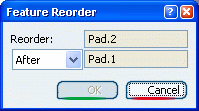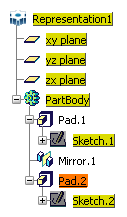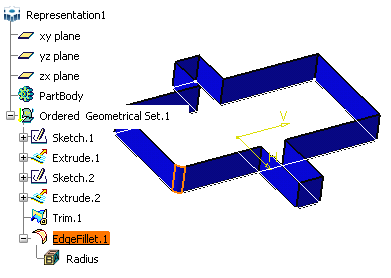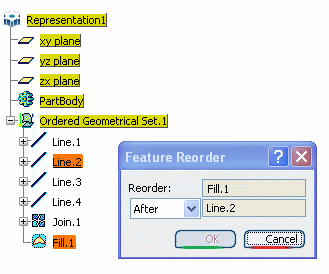About Reordering Features | |||||
|
| ||||
What You Can Do
-
There are three ways of moving features. You can reposition
them:
- After a feature you select (default option)
- Before a feature you select
- Inside a body, a solid body or a geometrical set. In this case, the feature is repositioned at the bottom position within the feature list.

-
You can reorder features located in a solid body (body
that does not integrate wireframe nor generative shape design geometry),
part body, body or ordered geometrical set. The general rule is that
a feature must remain in the same branch under the part where the notion
of order is defined. However, note that:
- Solid features can be moved from one body to another one even if these bodies do not belong to the same branch. However, these bodies must be of the same type: you cannot move a solid feature from a body to a solid body, nor move a solid feature from a solid body to a body. And additionally, a solid feature can only be moved to a body where there are no surface features.
- You can move a non-solid feature (GSD features, sketches and datum features) from an Ordered Geometrical Set to a Geometrical Set or Body provided ordering rules are complied: existing links allow the reorder operation without changing them. You can also move a non-solid feature from a Body to an Ordered Geometrical Set or Geometrical Set with the same restriction. Note that you will not be able to reorder back a surface from a Geometrical Set to an Ordered Geometrical Set.
- A root OGS (Ordered Geometrical Set located directly under the Part) can be reordered to any empty set. But the root OGS has to be reordered alone: if two root OGSs are selected, an error message will be issued.
![]()
Yellow Nodes
Non-available locations are indicated in yellow in the tree. A yellow feature indicates that the feature to be reordered cannot be located:
-
Below the yellow feature, if the position option you selected is After
-
Above the yellow feature, if the position option you selected is Before
-
Inside the yellow feature, if the position option you selected is Inside.
If you select one of these forbidden locations, an error
message is issued. In the example below, the user is trying to reorder Pad.2.
As indicated by the yellow color set on all of the nodes, this feature cannot
be reordered.

![]()
Specifying the New Location
In ordered structures, such as ordered geometrical sets or bodies, the Reorder command guaranties that the order is preserved.
Solid features are of only one type: they are all considered as modification features (except for the first one of the body)
In OGS or bodies, a distinction is to be made between modification features and creation features for surface features.
-
creation features (such as Extrude, Offset etc.) create a new object.
-
modification features (such as Split, Edge Fillet, Trim, Join etc.) create a new state in an existing object as well as absorb the preceding state.
When reordering surface features, the yellow node analysis is based upon the distinction between creation features and modification features. Both examples below illustrate the application behavior.
![]()
Update Operations
Before updating your design, you should remember that:
-
Manual Update If the Manual update option is on, a warning message is issued to inform you that you need to update the geometry.
-
Automatic Update If Automatic update is on, the whole 3D shape is updated.
We recommend you use Manual update for complex geometry. This will help you control the way you gradually rebuild your geometry. Depending on your reorder operation, you will see more easily how the different features of the 3D shape are affected.
![]()
In Work Objects
After reordering a feature in the specification tree, local objects are defined as follows: the application sets the first feature that is not affected by the reorder operation as the new defined in work object. This is convenient when using the Scan command after the reorder operation to update the modified geometry step-by-step.
-
When reordering upwards, the in work object is the feature positioned just before the new position of the reordered feature.
-
When reordering downwards, the in work object is the feature positioned just before the original position of the reordered feature.
![]()
Reordering Sketch-Based Features
When reordering sketch-based features, your environment configuration affects the way sketches are located in the specification tree. To know how sketches are located in the specification tree, see the Reordering Sketch-Based Features task.
![]()
Reordering Dress-Up Features
Remember that dress-up features cannot be created as the first features of bodies. Consequently, when reordering this type of features, you must keep in mind this rule which explains why you cannot reorder dress-up features just below bodies.
![]()
Reordering Modification Features
The general rule is that a modification feature can move within its main input chain.
Reordering Modification Features

In this case, EdgeFilet.1 is based upon Trim.1 which itself is a modification feature based upon Extrude.1 as the main input (the narrow rectangle) and Extrude.2 (the wider rectangle). So here, we have EdgeFillet.1 - Trim.1 - Extrude.1 as a main input feature chain.
Normally according to the rule previously defined, EdgeFillet.1 can move after Extrude.1 and not before. But for surface or volume features that can aggregate BRep features (vertices, edges, faces), when a multi-absorbing feature exists in the main input chain, those BRep features help the system decide where the reorder will be possible without update errors. So here in this case, the edge fillet points to an edge of Trim.1. This Trim.1 is a multi-absorbing feature absorbing Extrude.1 and Extrude.2. Since the pointed edge of Trim.1 originally comes from Extrude.2, the Reorder functionality allows to reorder EdgeFillet.1 after Extrude.2 but not before.
![]()
Reordering Creation Features
If a creation feature is directly based upon a modification feature (the Parent/Children capability lets you see this relationship), the rule is that you can reorder the creation feature within the main input chain of the modification feature. However, in some particular cases, the Reorder operation may result in update errors.
If you wish to reorder Fill.1 and locate it before Join.1, which is its parent, the application allows you to do so because Join.1 is a modification feature. As Line.1 is the main input of Join.1 and as Line.1 is a creation feature, the application allows you to reorder Fill.1 up to Line.1.

To know more about reordering features in geometrical sets and ordered geometrical sets, see the Managing Geometrical Sets and Managing Ordered Geometrical Sets tasks described in the Generative Shape Design User's Guide.